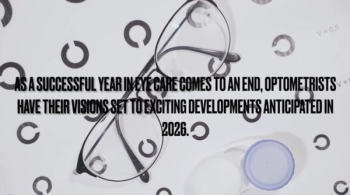
- January/February digital edition 2025
- Volume 17
- Issue 01
Early presbyopia noted in patients treated with FP receptor agonists for glaucoma
Attention to patients' near visual needs is warranted when choosing medications.
Patients with glaucoma who are using prostaglandin F (FP) receptor agonists to control their disease may experience accelerated progression of presbyopia as a result,1 according to Masahiko Ayaki, MD, and Kazuo Ichikawa, MD, PhD. The authors are, respectively, from the Otake Eye Clinic, Kanagawa, Japan, and the Chukyo Eye Clinic, Nagoya, Japan.
While the FP receptor agonists, which include latanoprost and bimatoprost, are the go-to medications to treat glaucoma, they are associated with adverse reactions that include dry eye,2 eyelid pigmentation, eyelash growth, iris pigmentation, and deepening of the upper eyelid sulcus.3
In addition, a few studies have reported that glaucoma medications are associated with surgical failure of trabeculectomy4 and accelerations of presbyopia progression.5-8 Clinical studies have suggested that the use of latanoprost reduces the accommodative amplitude6-8 and that patients with glaucoma using antiglaucoma eyedrops reached a specific near add power significantly earlier than controls,7,8 Ayaki and Ichikawa explained.
Research direction
With these effects in mind, they designed a study with 2 goals. First, they wanted to compare the frequency of ocular symptoms and the near add power between individuals with medically managed glaucoma and a control group in the early stages of presbyopia. In addition, they wanted to determine which specific glaucoma medications significantly affected near add power.
This study differed from others in that the investigators focused their efforts on detecting early presbyopia. The patients in the study were aged 40 to 49 years, which, the authors explained, is “an age range in which the relationship between age and accommodation amplitude is roughly linear9-11 and most individuals become aware of focusing difficulties and first use reading glasses. This approach allows us to compare glaucoma and control groups at an earlier age and identify potential factors contributing to the progression of presbyopia.”
Study groups and results
This cross-sectional study,1 published in the Journal of Clinical Medicine, included 105 patients (mean age, 46.4 years) with primary open-angle glaucoma and 114 controls (mean age, 46.1 years). All participants were phakic bilaterally and all had been treated with FP receptor agonists, β-blockers, or carbonic anhydrase inhibitors for at least 6 months. The investigators compared the near add power between the 2 groups.
The results showed that for the patients with glaucoma, the mean near add power and the prevalence of symptomatic presbyopia (near add power ≥1.50 diopters [D]) were 1.77 ± 0.71 D (P < .01) and 79.0% (P < .01). In contrast, the values for the controls were 1.16 ± 0.74 D and 42.1%.
The researchers found that the odds ratio (OR) and CI for symptomatic presbyopia were associated with age (OR, 1.36; CI, 1.21-1.52), ganglion cell complex thickness (OR, 0.96; CI, 0.94-0.99), presence of glaucoma (OR, 6.19; CI, 3.13-12.23), and number of glaucoma medications (OR, 4.26; CI, 2.42-7.43).
Among the medications studied, only the FP receptor agonists (OR, 5.79; CI, 2.68-12.32) produced significant results. Survival analysis showed that the patients with glaucoma reached the threshold of a near add power of +1.50 D significantly sooner than the controls (P < .05; log-rank test), the researchers reported.
The results led the authors to conclude that near add power increased exclusively with FP receptor agonists in patients with glaucoma during early presbyopia; however, this result was not observed with β-blockers or carbonic anhydrase inhibitors. For specific workers requiring intense accommodation, such as drivers, e-sports gamers, and athletes, cautious prescription of FP receptor agonists may be advisable.
They pointed out that research has suggested that bimatoprost had the most substantial effect on ciliary muscle contraction.12-14 It could be speculated that continuous muscle contraction due to FP receptor agonists may lead to decreased accommodative amplitude, they noted.
References
Ayaki M, Ichikawa K. Near add power of glaucoma patients with early presbyopia. J Clin Med. 2024;13(19):5675. doi:10.3390/jcm13195675
Fineide F, Lagali N, Adil MY, et al. Topical glaucoma medications—clinical implications for the ocular surface. Ocul Surf. 2022;26:19-49. doi:10.1016/j.jtos.2022.07.007
Inoue K, Shiokawa M, Katakura S, et al. Periocular adverse reactions to omidenepag isopropyl. Am J Ophthalmol. 2022;237:114-121. doi:10.1016/j.ajo.2021.12.011
Ishida A, Miki T, Naito T, Ichioka S, Takayanagi Y, Tanito M. Surgical results of trabeculectomy among groups stratified by prostaglandin-associated periorbitopathy severity. Ophthalmology. 2023;130(3):297-303. doi:10.1016/j.ophtha.2022.10.024
Weber J, Tuinenburg AE, van der Heijde GL. Effect of timolol on the amplitude and dynamics of accommodation. Doc Ophthalmol. 1989;72(3-4):41–47. doi:10.1007/BF00153502
Troiano P, Oldani A, Gozzini C, et al. Latanoprost 0.005%: evaluation of its effect on accommodative capacity. Acta Ophthalmol Scand Suppl. 2000;(232):52-54.doi:10.1111/j.1600-0420.2000.tb01104.x
Ayaki M, Tsuneyoshi Y, Yuki K, Tsubota K, Negishi K. Latanoprost could exacerbate the progression of presbyopia. PLoS ONE. 2019;14(1):e0211631. doi:10.1371/journal.pone.0211631
Ayaki M, Hanyuda A, Negishi K. Symptomatic presbyopia may develop earlier in patients with glaucoma—a cross-sectional retrospective cohort study. Transl Vis Sci Technol. 2024;13(4):21. doi:10.1167/tvst.13.4.21
Davies LN, Biswas S, Bullimore M, et al. BCLA CLEAR presbyopia: mechanism and optics. Cont Lens Anterior Eye. 2024;47(4):102185. doi:10.1016/j.clae.2024.102185
Pointer JS. Broken down by age and sex: the optical correction of presbyopia revisited. Ophthalmic Physiol Opt. 1995;15(5):439-443. https://pubmed.ncbi.nlm.nih.gov/8524571/
Pointer JS. Gender-related optical aspects of the onset of presbyopia. Ophthalmic Physiol Opt. 2002;22(2):126-129.doi:10.1046/j.1475-1313.2002.00012.x
Romano MR, Lograno MD. Evidence for the involvement of cannabinoid CB1 receptors in the bimatoprost-induced contractions on the human isolated ciliary muscle. Invest Ophthalmol Vis Sci. 2007;48(8):3677-3682. doi:10.1167/iovs.06-0896
Croft MA, Nork TM, Heatley G, Mcdonald JP, Katz A, Kaufman PL. Intraocular accommodative movements in monkeys; relationship to presbyopia. Exp Eye Res. 2022;222:109029. doi:10.1016/j.exer.2022.109029
Croft MA, Lütjen-Drecoll E, Kaufman PL. Age-related posterior ciliary muscle restriction—a link between trabecular meshwork and optic nerve head pathophysiology. Exp Eye Res. 2017;158:187-189. doi:10.1016/j.exer.2016.07.007
Articles in this issue
10 months ago
Education should be current, relevant, useful10 months ago
How do GLP-1 receptor agonists affect ocular health?10 months ago
Debunking myths about keratoconusNewsletter
Want more insights like this? Subscribe to Optometry Times and get clinical pearls and practice tips delivered straight to your inbox.













































.png)


